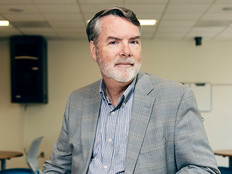EDUCAUSE 2011: Pew Research Reveals New Kind of Learner
Since its formation 11 years ago, the Pew Research Center’s Pew Internet & American Life Project has issued more than 300 reports based on its surveys that examine people’s online activities and the Internet's role in their lives. Research topics span a variety of activities and pursuits, demographics, and technology and media.
In a Thursday afternoon session at EDUCAUSE, Lee Rainie, the project’s director, explored how Pew’s latest research findings on how people use mobile devices dovetail with education. His remarks centered on three “Digital Revolutions” that have altered the way we learn and share information. Collectively, the rise of Internet and broadband adoption in the home (Revolution No. 1), the emergence of social networking (Revolution No. 2) and the evolution of mobile capabilities (Revolution No. 3) have transformed learning into an anytime, anywhere event.
The result, Rainie said, is that “we are all in this together, creating knowledge together.”
Key Findings
Pew research reveals that college and university students are highly connected. Among undergraduates, for example, 98 percent are Internet users, 93 percent are broadband users and 92 percent have wireless connectivity on their notebook computers or cell phones (or both).
Graduate students and community college students are similarly plugged in. Among graduate students, 99 percent use the Internet, 95 percent use broadband and 88 percent use wireless. By comparison, 94 percent of community college students use the Internet, 78 percent use broadband and 85 percent use wireless.
Just over a quarter of smartphone owners with at least some college education use the device as their primary means of going online. Texting, in particular, has skyrocketed among 18- to 24-year-olds, who each send and receive an average of 109.5 texts per day.
Learning on the Go
According to Rainie, the “new kinds of learners” emerging in this evolving digital environment are:
- more self-directed (and less top-down) in their acquisition and sharing of knowledge;
- better arrayed to capture new information inputs;
- more reliant on feedback;
- more inclined to collaborate;
- more open to cross-disciplinary insights and creating their own “tagged” taxonomies; and
- more oriented toward people acting as their own individual nodes of production.
To view Rainie’s complete presentation, visit Pew’s website.
For more coverage on EDUCAUSE 2011, visit our EDUCAUSE 2011 Coverage page.








